‘Is my action too high?’ is one of the most common worries or questions regarding a guitar and it’s setup. If you’re concerned your guitar action is too high then you’re in the right place. We’re going to look at what the ideal action measurement is and what’s considered too high.
And being worried about the action of your guitar is completely understandable. High action makes a guitar much more difficult to play. Depending on how high the action is sometimes it makes it virtually impossible to play!
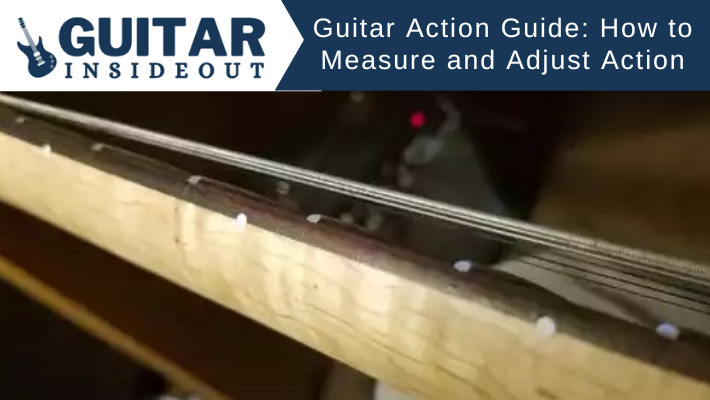
I spent a long time trying to get mine just right and so know how frustrating it can be. But with this guide you’ll learn what action is, ways to measure it, why it’s so important and how to adjust the action of electric and acoustic guitars.
So let’s get started.
What is Guitar Action
Guitar action is the distance between the strings and the fretboard. The height the strings are from the fretboard is crucially important to how a guitar plays. If the action is too high then it will make holding the strings down more difficult and the guitar harder to play. If the action is too low then the strings will buzz and affect the tone.
The action of a guitar is very personal though and and also differs depending on the style of music being played. Some guitarists prefer higher action because it suits the way they play – it could be they do lots of string bending or really attack the strings, both of which are helped by having a higher action.
Others need much lower action if they have a very light touch or are really shredding and playing extremely fast.
But going too far to the extremes on either side is going to cause issues. Very high action will make playing much more difficult and really hold you back. Too low action causes a lot of fret buzz, fretting out of notes and a huge reduction in sustain.
I personally prefer my action very much on the lower side but it really is all about finding what works for you. It might take some trial and error and will differ depending on each guitar but eventually you’ll find what works best for your playing style.
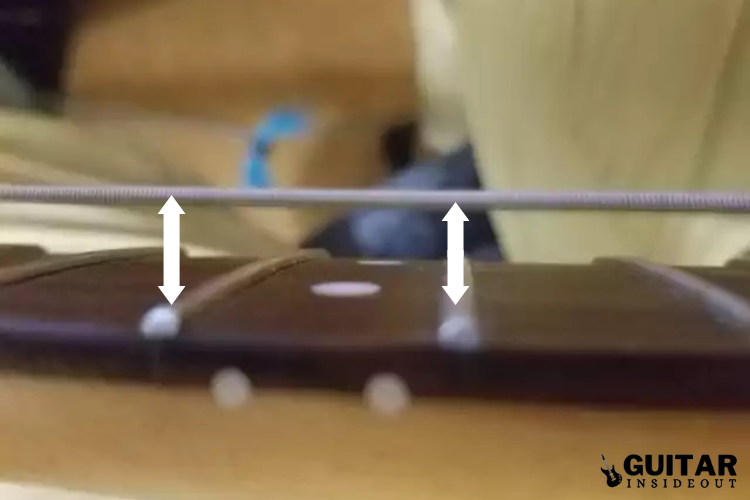
How to Measure Guitar Action
There are a few ways you can measure the action of your guitar.
You can either use a ruler or an action gauge, which is a specific tool that helps with the measuring. With a ruler you place the end of it against the 12th fret (the metal fret itself, not the space between frets!) and see the length between the bottom of the guitar string and the top of the fret.
That figure is the height of your action. It’s usually measured in millimetres (mm) or inches (example: 3/16th”).
The action gauge works the same way, it’s just a tool designed to make it a little simpler.
Measuring with a Ruler
A key part of measuring action with a ruler is that the ruler must start from the very edge. You will find a lot of rulers have a little gap before starting which makes them useless for this purpose (they’re mostly suited for drawing rather than measuring).
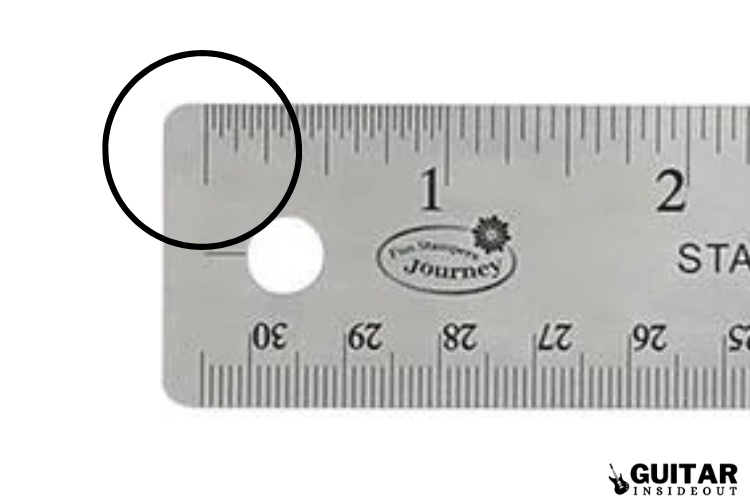
If you place the end of that type of ruler against the fret and there’s a few millimetres before it begins you’re not getting an accurate measurement. The measurement you get is actually much greater because of that unmarked gap.
So you must use a ruler that begins at the 0 line. You can then put it directly against the fret and measure from that point.
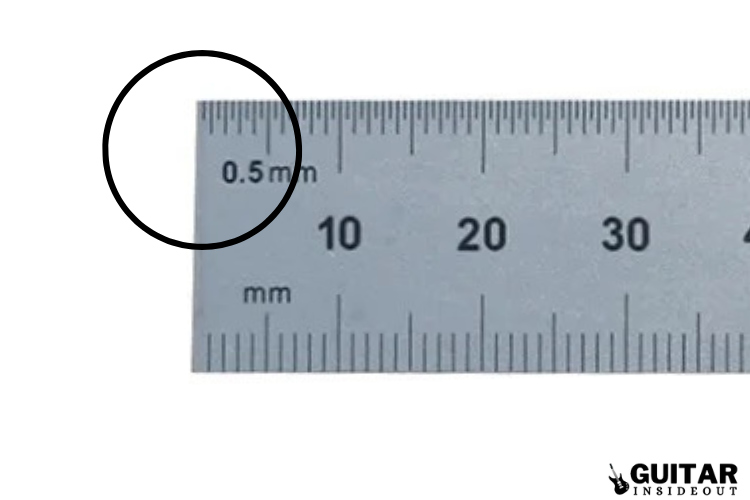
Measuring with an Action Gauge
You can buy a little tool called an “action gauge” that is like a small ruler designed specifically for measuring guitar action. You get measurements in both millimetres and inches and depending on how much you’re willing to spend you can get ones that have fret height and nut height measurements too.
I actually bought a cheap action gauge off of eBay a couple of years ago (you can get the same one on Amazon). Mainly because I didn’t have a ruler that started at 0 and the action gauge was cheaper than buying one!
But it’s quite handy and does the job well enough. It’s also a lot smaller and easier to store or take with you than a full size ruler.
Step by Step Guide
It’s actual very easy to measure your guitars action. Just follow these few steps:
- Make sure your guitar is tuned first. That’s important because you need to have the correct tension in the strings and on the neck when you measure the action.
- Check to ensure the neck of your guitar is straight. Adjust if needed until it is.
- Hold your guitar in the playing position. This is important because if you try to measure the action with the guitar resting on its back gravity will bend the neck slightly but enough to throw the measurement off.
- Place your ruler or string gauge on the 12th fret of the low E string.
- You take the measurement from the bottom of the string. So look at where the bottom of the string is against the ruler and that’s the action height.
- Repeat on every string until you have the measurements.
If you have a Fender type of bridge where you can adjust the string height at each saddle then you will need to get the measurements for every string.
So you now should have measurements for each string. The next step is knowing whether they are too high or too low.
Is Your Action too High?
So, how do you know if your action is too high?
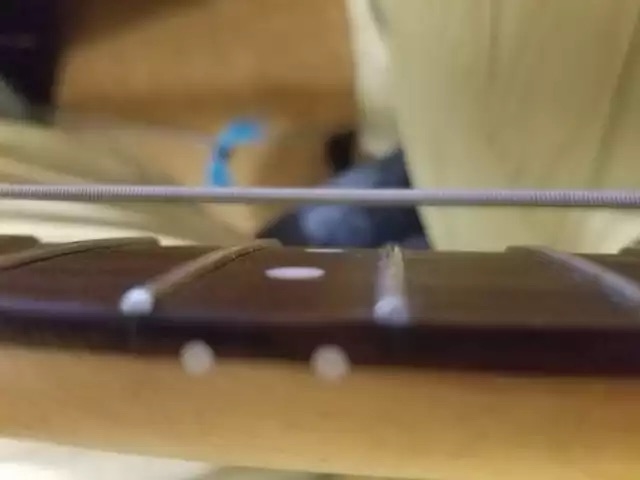
Well if it looks anything like that picture then it’s too high!
A lot of action comes down to how it feels. If your guitar plays well and feels comfortable to you then the action probably doesn’t need adjusting.
But if it’s hard to hold the strings down or you’ve noticed there’s a pretty big distance between the fretboard and strings you might have too high action. A guitar that is uncomfortable to play is often due to high action. Also if your intonation is way off that can be a sign of high action too.
Intonation is affected by having high action because the higher the strings from the fretboard the greater the distance you have to press the strings down. This leads to the note going out of tune as the string bends.
But even if you aren’t experiencing any of that mentioned above you still might want to experiment with different heights to see if you find them preferable.
What Should Guitar Action Be?
Whilst it’s really an individual choice there are some standard action measurements for both electric and acoustic guitars.
Electric Guitar Action
The standard action on an electric guitar is roughly 1.6mm (1/16″ or 0.062″) on the high E string and 2mm (5/64″ or 0.078″) on the low E string.
However depending on the guitar you can go much lower. Dan Erlewine, who wrote the book ‘< href="https://www.amazon.com/dp/0879309989/?tag=guitarinsideout-20" rel="nofollow noopener" target="_blank">How to Make Your Electric Guitar Play Great‘ (amazing book, well worth getting if you’re interested in doing your own setups) recommends 1mm (2.5/64″ or 0.039″) for the high E string and 1.6mm (1/16″ or 0.063″) for the low E.
That’s definitely on the lower side but very possible and quite common in more shredding style guitars (Ibanez’s, Jackson’s etc.)
Acoustic Guitar Action
The standard action on an acoustic guitar is roughly 2mm (5/64″ or 0.078″) on the high E string and 2.5mm (3/32″ or 0.093″) on the low E string.
Acoustic guitars have a higher action than electrics. This is because of the way an acoustic guitar generates sound.
When you pluck the strings or strum a chord the strings vibrate. The sound box (the hollow area of the guitar) takes those vibrations and amplifies them, creating the sound you hear.
So the vibrations of the strings is crucial to this. But if the action was very low then the strings would vibrate far less and the sound from them would be reduced dramatically. That’s why acoustic guitars need a higher action.
How High is too High Action?
Any action that you find uncomfortable to play can be considered too high. But anything over 3-3.5mm (0.117″ – 0.138″) at both the high and low E strings would be considered by most guitarists to be high action on an electric guitar.
On an acoustic guitar high action would be anything over 3.2mm (0.126″) on the high E string and over 3.8mm (0.149″) on the low E.
However if you felt able to play at that height then it doesn’t matter what is thought of as high action. A guitars action should be about what feels right rather than a specific measurement or number.
High vs Low Action: Which is Better?
This really comes down to what you personally prefer. There isn’t a right or wrong answer because both high and low action can work and sound good.
High action is suited to an aggressive style of playing, hitting the strings hard, lots of bending. You want as little fret buzz as possible when playing like this. Low action suits a lighter touch with gentle picking whereby it doesn’t matter if the strings are so low that they buzz.
A lot of blues guitarists use guitars with high action as they don’t need to worry about playing very fast and like the tone the higher action gives them. That higher string height also allows them to do big bends and really dig in and attack the strings.
Alternatively metal guitarists often prefer very low action as it’s much easier to play faster and more technical styles.
But for the majority of people a lower action will be easier to play and generally preferable. You tend to have to compromise between keeping the strings as low as you can but avoiding any major fret buzzing.
The usual way to of finding the ‘sweet spot’ is to lower the action until you start to get fret buzz. Then raise it slightly until there’s no buzzing and you’ve hit the point of the lowest action without any fret buzz.
And if you’re a beginner then anything that makes playing easier in the early stages seems like a good idea to me. I know there are some people who think higher action when you’re starting out is good because it builds finger strength.
But I wonder how many people get frustrated and give up because they get a poorly setup guitar with high action that they really struggle with. Those early stages are hard and if a good, low action helps and encourages newbies to stick with it I’m all for that.
How to Adjust Action on an Electric Guitar
Adjusting the action of an electric guitar is far simpler than you might think. But the type of bridge your guitar has plays a big part in how you do it.
A Gibson style of bridge like a Tune-O-Matic only allows you to adjust the height on the treble and bass sides. This differs greatly from a Fender style bridge where you can adjust the height of each string saddle individually.
Fender Bridges
Before adjusting the action on a Fender style bridge you will need a 1.5mm Allen wrench. This is used in the two small screws on each saddle (see picture below).
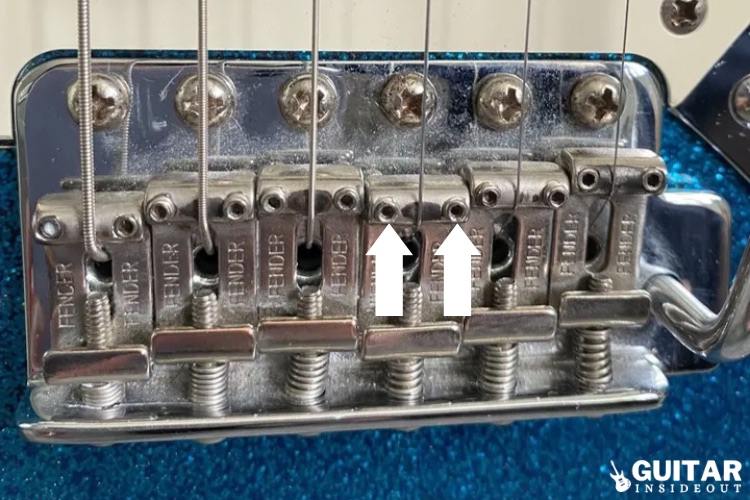
- Start with by taking a measurement of the low E string at the 12th fret.
- If you think it needs adjusting turn the Allen wrench in the saddle to either raise or lower it.
- Retune your guitar and play to see if it feels better. If so then you can remeasure and take that as the figure to use for the other strings.
- Repeat on each string until every one feels right and plays how you like.
- You can make the low E and treble side strings slightly lower than the others if you like. This is fairly common rather than having every string the exact same height.
Tune-O-Matic Bridges
You don’t need any tools to adjust a Tune-O-Matic bridge. You also don’t need to measure and adjust each string individually, because you can’t.
Instead you turn two screws on the bridge posts (see picture below). These will raise or lower, depending on which way you turn them, the bass and treble side.

It means you only need to measure the high and low E strings.
- Begin by measuring the low E string at the 12th fret. If it’s too high then turn the screw nearest to the low E string until it has lowered enough.
- Retune your guitar, see if it plays how you like and if so remeasure. If it’s not enough then lower it some more and repeat until you’ve got it to your liking.
- Now move to the high E string and repeat the same steps.
- Lastly check the measurements and feel of the middle strings. As you can’t adjust those individually you will have to keep readjusting the high and low E strings until you’ve found the right balance.
Floyd Rose Bridges
Floyd Rose bridges are similar to Tune-O-Matic’s in the way you adjust their action. They have two posts that you use to change the action.

The difference is you need to use an Allen wrench/key to adjust them. So you will require a 3mm Allen wrench before getting started.
After that it’s the same process as the Tune-O-Matic described above except you turn the Allen wrench in the bridge studs rather than turning the screw.
How to Adjust Action on an Acoustic Guitar
Compared to an electric adjusting the action on an acoustic guitar is much more difficult. On an electric guitar if you make a mistake you can easily fix it or reverse what you just did. It takes a lot to really mess your electric guitar up just by adjusting the action!
But with an acoustic guitar you have to physically alter the saddle. If you want a lower action you need to file or sand it’s saddle down.
That means if you go too far or make an error you’re stuck – there’s no going back. It’s permanent.
Raising the action requires either a shim to increase the height of the saddle or a total replacement. None of this is easy so you need to feel a lot more confident and comfortable when it comes to adjusting the action on an acoustic guitar.
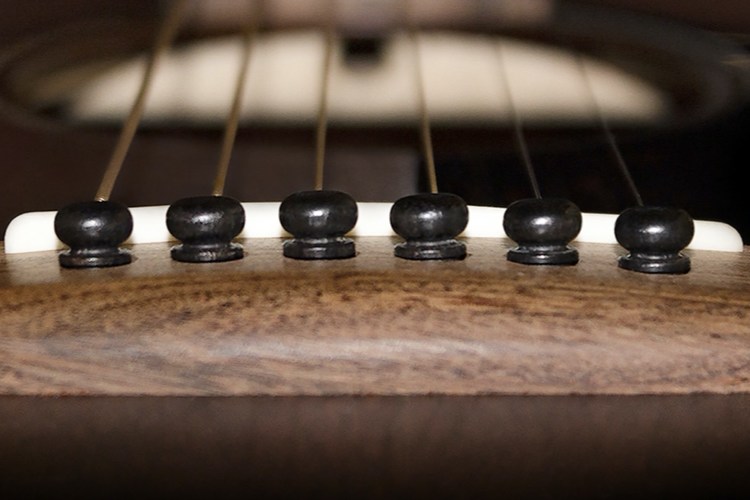
I’d definitely recommend you getting a professional to do either of those if you are even the slightest bit unsure. You don’t want to ruin your guitar.
If you do want to try yourself then measure the action first before removing the saddle. Then slacken then strings so you can slide the saddle out.
Make a straight line mark on the saddle with pen and ruler so you know where to stop. Start very slow with filing the saddle down.
If you go too far you’ll have to buy a new saddle. Also creating a curve in the base of the saddle will mean you’ll have to replace it.
Do it in stages. Take a small amount off, return the saddle to the bridge, retune and remeasure the action. If it’s not enough then remove it and file a little more. This will be time consuming but should help you to avoid any mistakes.
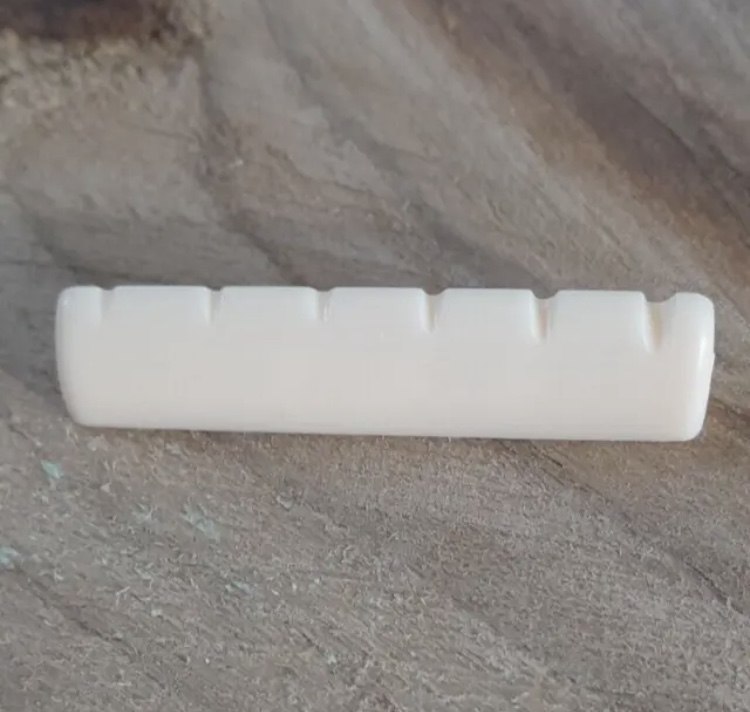
Why Has Your Action Changed?
Sometimes you will find that the action on your guitar has changed without you doing anything. There are a few reasons that could be behind this.
String Gauge
Changing the gauge of strings on your guitar, especially going to heavier gauge strings, can definitely affect the action. The heavier gauge of string the more tension it is putting on the neck. This can easily lead to an rise in height of strings from the fretboard.
Humidity
A change in humidity can have a pretty drastic impact on a guitar. For example over the last summer the temperature and humidity where I live shot up quickly for a few days.
After it had passed I took my Telecaster out of its case and there was a huge crack running along the edge of it. I hadn’t touched the guitar in all that time so it must have been the sudden change in humidity and temperature causing the wood to warp or swell.
The humidity also affects the neck and can cause it to bow forward. This would raise the action too without you realizing.
Action and Playability
The main aim for most guitarists when adjusting the action is to make their guitar both play and sound better. That’s because the action has a noticeable difference on how it plays and and the tone you get.
Does Higher Action Give you a Better Tone?
A higher action definitely influences the tone you get from your guitar. High action can give you a fuller tone that sounds more open. You also get a greater sustain from the notes played with a higher action.
The gauge of strings is also important when it comes to tone. Thicker and heavier gauge strings give a richer, more full sound but are harder to play and also require a higher action.
But it all depends on what sort of tone you want. For some people the sound from a heavier gauged guitar with high action won’t be what they’re looking for.
And let’s face it, if you’re struggling to play well because the action is too high it won’t matter how good the tone is!
Is Lower Action Easier to Play?
Yes. The lower the action the closer the strings are to the fretboard which makes it a lot easier to press and hold the strings down. Much less effort will be needed and it should be far easier to play the guitar.
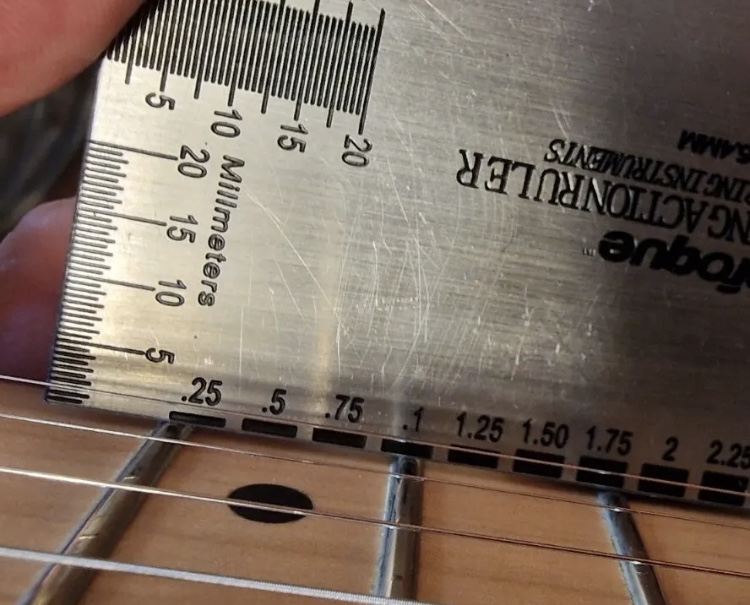
Does Lower Action Make Bending Easier?
There are a lot of variables involved but while it may seem counter intuitive higher action is actually easier for bending. With low action you are more likely slip off the string or fret out when trying to bend. Higher action may need a bit more strength but you can get a proper grip on the string.
Can you Play Fast with High Action?
Yes but it’s definitely more difficult. There are lots of famous guitarists who have had high action, or at least not low action, and still played fast.
Lower action should make playing quickly easier but some guitarists prefer high action. It just suits their style or the way they play.
So it’s best to experiment and find what feels best. You might end up surprised.
Do you Need Low Action to Play Fast?
You don’t need low action to play fast but it should help. With less distance between the strings and fretboard it means you don’t have to put as much effort in to press the strings down. This should allow you to play more smoothly and glide across the fretboard and strings faster.
Does Lower Action Help with Tapping?
Yes, if you are doing a lot of tapping then a lower action will make it easier. Getting the correct technique of probably more important but it will certainly be less strenuous with lower action.
Guitar Action FAQ
Why do Cheap Guitars have High Action?
Doing a full setup and getting a good action takes time. Time is money. If you’re producing a lot of guitars for cheap you aren’t going to waste time and money on making sure they’re perfectly setup.
Cheaper and beginner guitars tend to be mass produced off a production line by machines as well. That’s very different from a higher end guitar that may be handmade or at the very least checked over by a guitar tech before it’s given the thumbs up to be sold.
You’ve also got to factor in that guitars are often shipped around the world, or at the least fairly long distances, with changes in humidity and weather that will affect the action.
Does Action Height Affect Intonation?
Yes because the greater distance needed to push the strings down causes them to go out of tune. Low action doesn’t suffer from this problem.
How do you Know if your Guitar Action is too Low?
If you’re getting a lot of fret buzz and strings rattling against the fretboard then the action is probably too low. A little is acceptable but if it’s causing problems when playing or just sounds wrong then try raising the action and see if that solves it.
Is a Little Fret Buzz OK?
Yes, having a little bit of fret buzz is fine. Especially in an electric guitar if you are noticing it unplugged. That’s to be expected.
But it does depend on how low you want your action. There are some guitarists who can’t stand any buzz whatsoever and will set their action with that in mind. There are others who prefer the low action and are happy with a little bit of fret buzz in order to get it.


Hi Andy. I’m a “Conservatory” player of a Taylor GS Mini. I realise it’s a fine smaller guitar, but I wasn’t happy with the factory strings, or the fact they felt too thick to me. I changed them for a light gauge, and although they sound better, particularly in the strumming, they are looser than I expected. I have read (somewhere) that going back to the factory gauge, and having the guitar set up (which it never has been), perhaps including the bridge, works well, leaving the guitar playing more easily, and sounding perfect. What do you think? I’d appreciate your opinion before I make a decision.
I’ve Taylor GS Mini mahogany with D’Addario 80/20 custom light 11-52 strings and the tension is fine, gives it a richer brighter tone, also have an insane low action with no buzz at 1.5mm low E / 1.0mm high E.